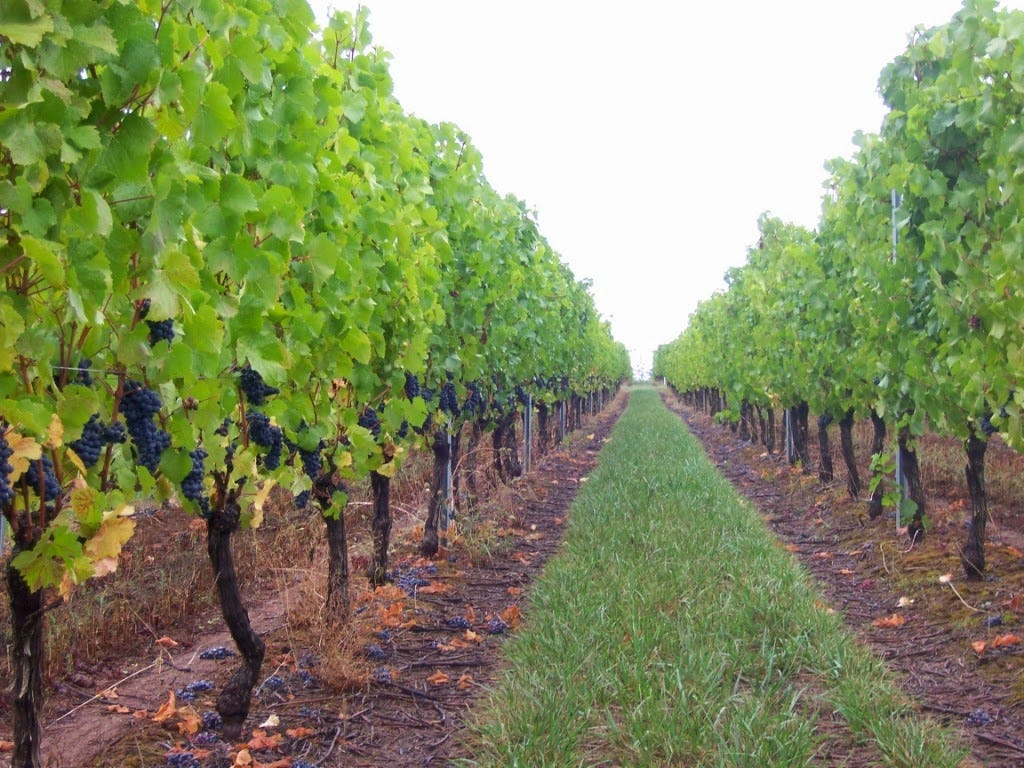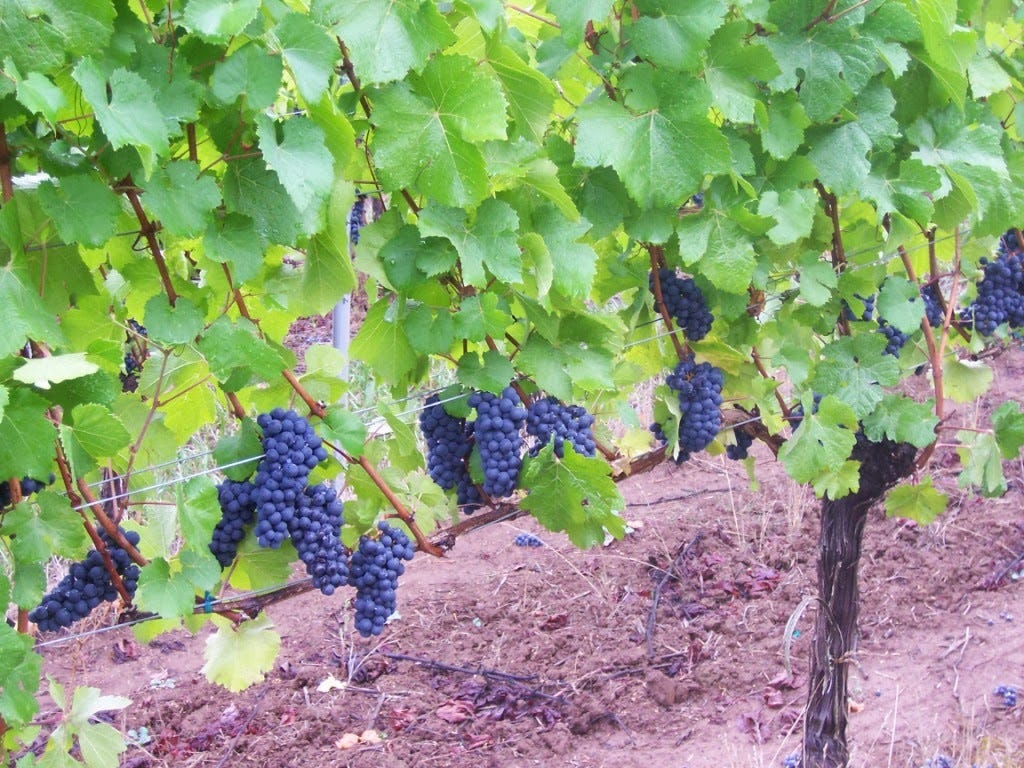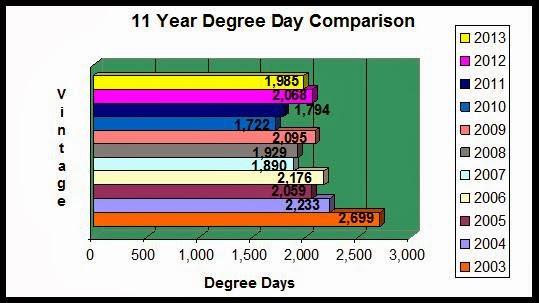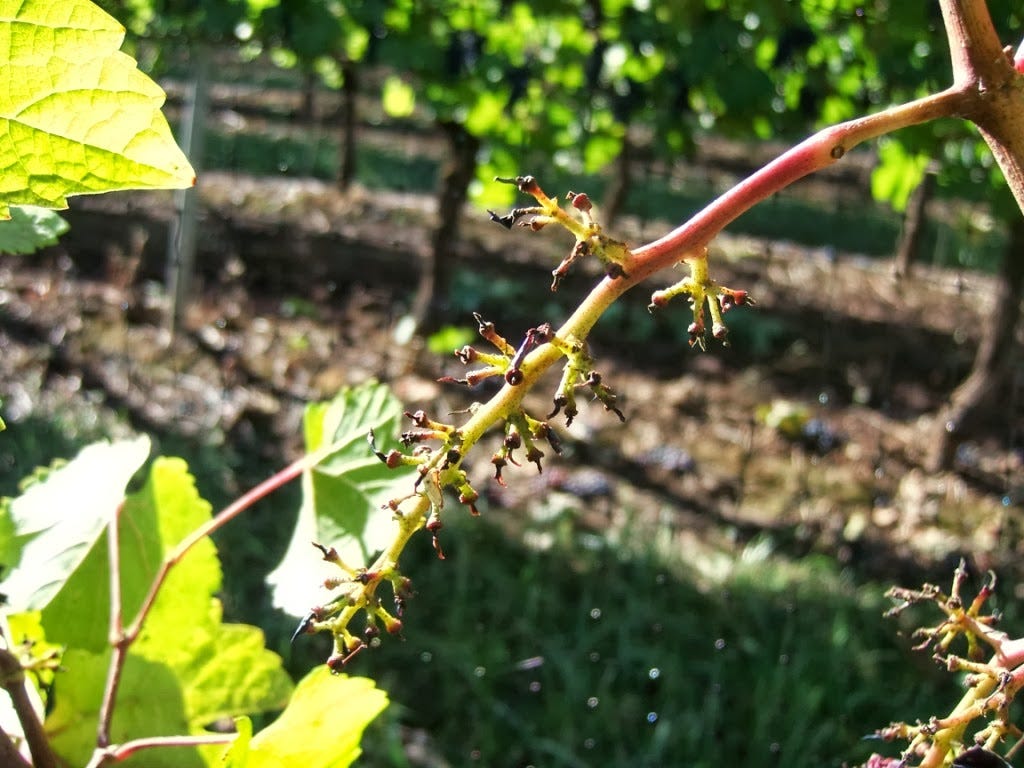Amalie Robert Climate Update: 2013 Mid-September
Hello and Welcome,
This is the climate update for Mid-September 2013.
We spend a significant amount of time and go to a good deal of trouble to explain what we do in the vineyard and winery. Perhaps we have been going about this all wrong. Why just the other day, and for quite a few days now, we keep hearing about the data collection and data mining efforts that are being undertaken, or just taken, on our behalf. And recently we have had this crazy craving for Russian Caviar.

Soon we will be launching our own “Vineyard Vision.” Ernie has had a few spare moments, and you would be amazed at what he can cobble together out of that old flail mower and a few other pieces of “vintage” farm equipment. Sometime after harvest we will be launching our very own Interactive Communications Uplink (ICU) Satellite. Yep, there will be an app for that, for sure, for sure, good buddy!

Now we know this has been tried before, but with limited success. You see that was before the Smartphone and all those (foreign and domestic) Smartphone apps that are tracking our every move, credit card transaction, conversation, and perhaps image capture as well. And how do they get your driving directions so accurate? This is fertile ground to till, friends.
Meanwhile back on the farm, September has been one heck of a ride! You can see what we mean by going to Google Maps and typing in 13531 Bursell Road, Dallas, Oregon. Try it on your Smartphone…

September has been running hot and warm. We have seen the August trend continue, but with an unexpected shower of about an inch of rain. Ernie was really hoping for some cool rain to slow down the sugar accumulation in the wineberries. What he got was warm rain and plenty of it.
For those of you that are new to this communiqué, hold onto your apps. One inch of rain over an acre of land is 27,150 gallons of water. We received this gift from Mother Nature during the evening hours of September 5th. This was big water in a short window. Our vines are planted at a density of 1,452 per acre. So you would not be inaccurate to say that each vine just gained access to a little over 18 gallons of water. We like to see the vines produce enough fruit to produce one bottle of wine per vine* – that is about 0.2 gallons. You old timers would know this as “a fifth.”
* Each ton of Pinot Noir harvested produces just about 60 cases of wine. Two tons of Pinot Noir from an acre of land will yield 120 cases (1,440 bottles) of wine from 1,452 vines.
You may be asking yourself where all of that rain is going to go. That would be a very good question, and is exactly what is on Ernie’s mind. There are only 2 places that much water can go:
First and fastest is the grass. Every other row of the vineyard has a permanent grass row. We use Tall Fescue as it has deep roots to survive our dry farmed vineyard in the summer. Now we had a little shot of rain at the end of August, about 0.25 inches. This woke up the grass and it started to green up. That means the grass is ready to take up a portion of this new rainfall. The warm temperatures are also helping it to grow. Nice.
The other half of the vineyard holds our fertilizer for this fall – Vetch to set Nitrogen and Buckwheat to help with Phosphorus uptake in the vines. These are 2 macronutrients the vines need every year. But those plants are pretty much dormant from the dry summer and are not going to take up a significant amount of that water. Not so much.

That leaves us with the water percolating down thorough the soil profile where the roots are waiting. Not much else they can do really. It’s not like they are going to run to town for beers. That’s our job.
The canopy is now in control. The leaves have a capillary ability to pull water from the soil via the roots. As the sun shines down on the leaves they carry out photosynthesis, convert that nasty carbon dioxide into oxygen that we all need and absorb heat. They cool themselves by opening stomata on their backside and release a little water vapor along with the oxygen. This is a very natural and biologically necessary function in most plants and many animals, some more than others – usually the males. So, the more leaves we have and the warmer the temperatures, the more of the available soil moisture will be transpired through the leaves. Very good.
Along with the leaves transpiring this moisture into the atmosphere, the wineberries are strategically positioned between the roots and the leaves to pick up some of this water on the way by. This can be good since the wineberries have had a hot and dry summer where they have desiccated a bit. This means the sugars will read very high because there is very little water left in the berry. High sugar accumulation before flavor development is bad, so we like a little moisture in the wineberries. Good.
However, an inch of rain is not a little moisture. The risk we are now exposed to is split berries and Botrytis bunch rot. As the leaves are pulling up moisture, the berries are packing it in. Late in the season the cell walls in the skins are starting to break down and release aromas that are like pheromones that stimulate the animal urges in … animals. This is good for wine quality as well, especially if you believe that a fine Pinot Noir is the embodiment of sex in a glass. Yeah, I’ll take a piece of that action!
However when these cell walls break down and the skins start to thin out it means too much water can burst the berry. When this happens, the cluster will start to rot with Botrytis. This is not good, as the cluster is now lost. No animal will eat that cluster when the cluster 3 inches away is just fine. Now that cluster is lost as well, and so on. Not so nice.

Ergo, the growing season to date has been quite warm and dry. The wineberries had been reading high sugars that meant an early harvest to keep alcohol levels down, but without great flavor development. This early September soaking has had the effect of diluting those sugars and thereby allowing for a little more hang time to develop those sexy, silky flavors we so desire. Now if they just hold together and don’t split we will be out to get them in a jiffy!
Let’s have a look at the numbers, and maybe a nice cold farming bier. That’s right, Okto-vember is just around the corner!
The first 15 days of September accumulated 248.3 degree days, had a high of 94.9 (recorded on 9/11 at 3:20 pm) and a low of 50.9 (recorded 9/7 at 3:20 am) for a 2013 growing season total of 1,985.3. This number looks a lot like 2,000 degree days which marks a nice cool climate growing season especially suited to Pinot Noir.

And we had rain. The evening of September 5th brought us a full inch, increasing the growing season total to 7.53 inches. Well (a hole in the ground with water in it), the grass certainly has greened up!

From here on in anything could happen and probably will. The warm temperatures up into the 90s after our early September rain event helped to green up the grass and rehydrate the wineberries. The rest of September is looking kinda carppy with miserable little cloud outbursts here and hopefully over there. The good news is that we have finally slowed down the growing season to let the flavors catch up with the sugars. However, we now face the risk of split berries and Botrytis bunch rot. If 2011 was a character building vintage, success in 2013 will be marked by nimble harvest operations ready to go at a moments notice. That’s how the birds do it. Welcome to the advanced class.
Bonus Material: For those of you actually considering getting into growing wine in Oregon, please refresh yourselves on the definitions of the following 2 words: Could and Should. As used in a sentence: “Oh sure, I could grow great wineberries.” And “Growing wineberries and placing my family’s entire financial future in Mother Nature’s hands is not something I should be doing.” May we suggest writing the second sentence on a cocktail napkin and carrying it with you during the evening hours in case the need to use it suddenly arises?
This is what we had to say for Mid-September 2012:
Ah, the numbers. We take a reading mid month in September because we can. It is just another data point along the way and helps us to understand our fruit development coming down the home stretch. Through the 15th of September, we have accumulated 244 Degree Days, for a growing season to date total of 1,718. We are only 4 Degree Days short of the entire 2010 growing season of 1,722! But wait, there's more.
Our high temperature was 97.1 and our low temperature for the month was a brisk 41.0 degrees Fahrenheit. There was no rainfall in the first 15 days of September. Rainfall since April 1st through September 15th remains 8.96 inches. A full and comparative report will be provided at month end.
But heat units aren't the whole story. We need time for the berries to ripen their seeds and ultimately develop stunning flavors and aromas while maintaining vibrant acidity. Besides, the birds aren't here yet. The real excitement begins in the second half of September. We expect a little precipitation, but who knows when.
In the past few cool vintages, it has been the latter half of September and the first half of October that Mother Nature decided to send a little love our way. Then there was 2011, where September felt like April and we burned through all of October to finish our Pinot Noir harvest the first week of November! That tingling sensation originated just below our spines. We think of the 2011 vintage often, but not fondly.
"Lean into it" they say. Yep, that's what’s next - Okto-vember. More than any other time during the year, this 61 day period is when we switch from wine to bier. It's a Germanic thing. See you next month!
Kindest Regards,
Dena & Ernie



